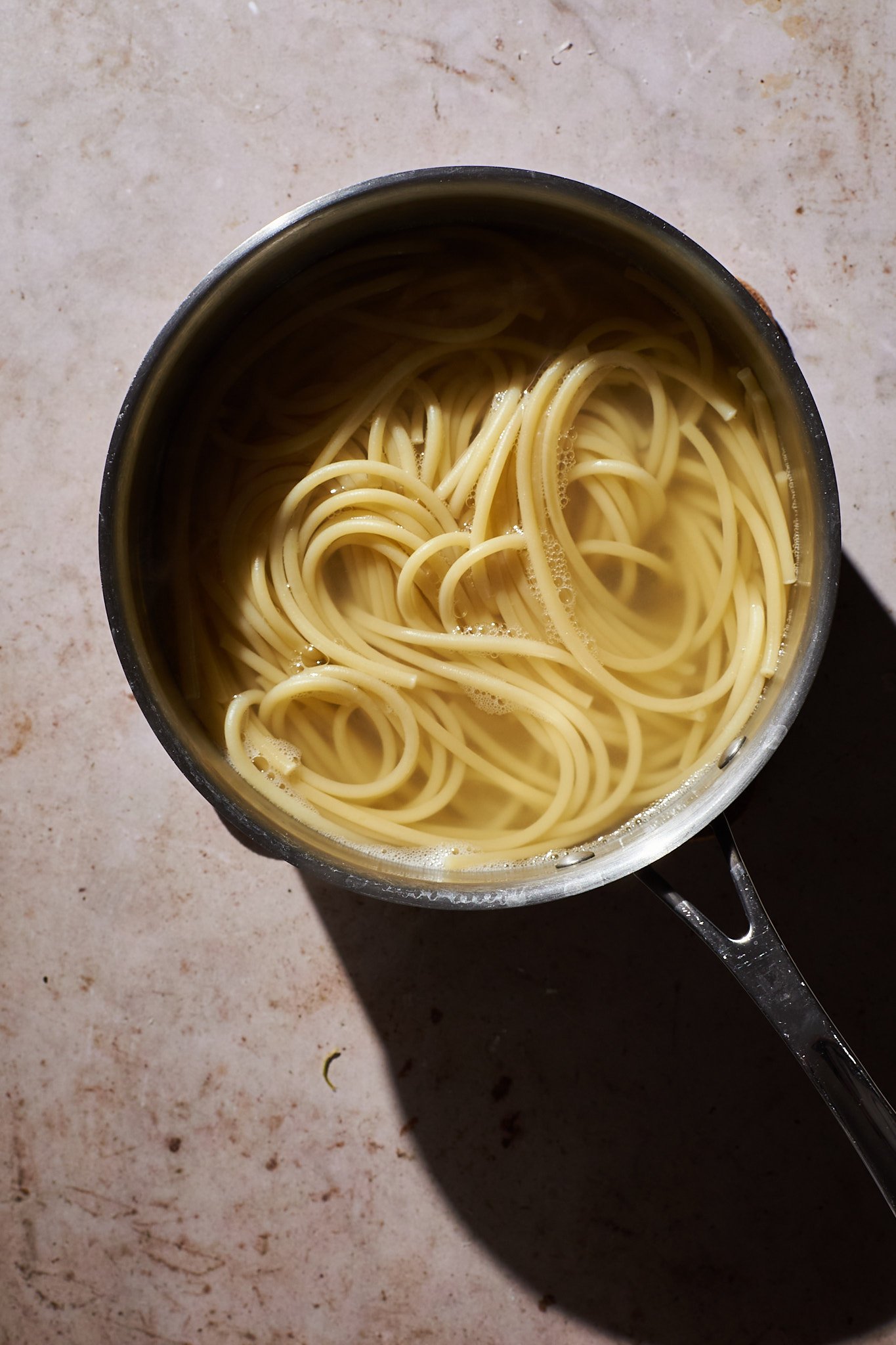spicy canned mackerel puttanesca.
Ingredients
1 pound bucatini, or any long pasta like angel hair, spaghetti, or linguini
2 tablespoons olive oil
3 cloves garlic, minced
1 large Fresno chile, sliced
1 (6-ounce) can black olives
1 (3.75-ounce) tin mackerel
1 (15-ounce) can tomato sauce
1 (14.5 ounce) can whole peeled tomatoes
1 tablespoon white wine vinegar
Pinch salt
1/4 cup finely chopped parsley
RECIPE
Boil the pasta, reserving a 1/2 cup pasta water. Drain.
Heat oil in a deep skillet over medium heat.
Add garlic and chilies and stir constantly until fragrant, about 1 minute.
Add the olives and mackerel and stir constantly until mackerel is slightly browned, about 3-4 minutes. Do not allow garlic to burn.
As the mackerel starts sticking to the bottom, add the tomato sauce and tomatoes. Crush tomatoes with the back of a spoon and stir to combine. Bring to a simmer.
Add the white wine vinegar and salt. Let simmer until thick, about 3-4 minutes. Turn heat to low if sauce is splattering.
Add pasta, tossing to coat. If needed, add the pasta water a splash at a time until pasta is well coated.
To serve, sprinkle with parsley.
NOTES
Unless you can find half-sized cans, I recommend making this sauce recipe in full even if you are planning to make 2 servings. You can either eat it as an extra-saucy puttanesca, or you can scoop out half of the sauce and freeze it or store it for later. This will be much easier than saving several half-used cans of tomato sauce and olives.
Bucatini takes about 10 minutes to make. Boil the water while you mince the garlic and chop the chiles, then add the pasta and let it cook for a few minutes before starting the sauce. Ideally, the bucatini should come to al dente as the tomatoes come to a simmer so that the bucatini doesn't dry out and stick.
This dish is also great with grated parmesan or romano cheese on top.
Puttanesca is a classic pasta sauce that was invented in Naples, Italy in the mid-20th century. Having probably just glossed over that number, it’s worth noting that this sauce isn’t centuries old like so many other Italian sauces. Mid-20th century puts it at about 1940-50, right around World War II. In other words, not that long ago.
I had some vague understanding of puttanesca’s history, but I’m also guilty of assuming it was some super-old sauce made before stovetops existed. According to Thrillest, puttanesca roughly translates to “lady of the night” and was named after the prostitutes of 1950’s Italy. Their article suggests the dish was named for the “pungent” aroma of the dish (the implication being that it smells like said prostitutes), but it’s a little more likely that the combination of aromatic ingredients was simply what the ladies had on hand to eat between clients. I like to imagine that the story was a little more romantic; maybe a chef fell in love with a prostitute and cooked her this dish one night —but that’s almost never how food history works.
Even though it was made much later than most classic sauces, the blueprint for puttanesca is generally the same: Cheap ingredients, put together in a hearty dish as a means of survival. The ingredients that make puttanesca what it is are anchovies, tomatoes, capers, olives, garlic, and olive oil. None of these are necessarily expensive, and most should already be in your pantry.
This puttanesca utilizes canned mackerel instead of anchovies, which emphasizes the fishy depth of the sauce. Because mackerel is a little more fishy than anchovy, I left out the capers, opting instead to go spicier with the chiles.
Puttanesca usually has red pepper flakes for heat, but to amp it up just a little bit, I used sliced Fresno chile. You can swap for any kind of red spicy pepper, or omit it if you want it more mild.
The tomatoes used are canned, which are peeled and stored in sauce, making them a faster option for homemade sauce. You can use anything, technically, but for fresh flavor, I suggest whole peeled San Marzanos and a good-quality sauce or purée.
Enjoy.
Serves: 4
Prep time: 5 minutes Cook Time: 15 minutes
open up the garlic and chiles in oil to start.
use the back of the spoon to crush the tomatoes into the sauce.





